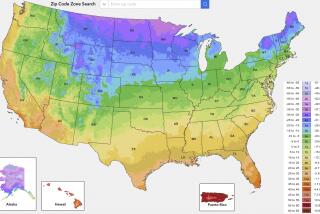Longer Growing Season Reported by Researchers
- Share via
Spring has been arriving earlier in the Northern Hemisphere--possibly due to global warming--with the result that the growing season in many countries is a week longer than 20 years ago, scientists announced Wednesday.
It is the first time that such a widespread increase in the growing season has been reported, the scientists said.
Researchers at the Scripps Institution of Oceanography and UC San Diego, who have monitored seasonal changes in the atmosphere for almost 40 years, say their finding suggests that plant life in North America, Europe and Siberia may be responding to the effects of global warming.
Driven by steadily rising temperatures, the amount of vegetation in those regions appears to have increased by as much as a fifth since the mid-1970s, they determined.
“This may be the first evidence of climate change and how it affects the growth of plants on a huge spatial scale,” said Pieter Tans, an authority on greenhouse gases and the atmosphere at the National Oceanographic and Atmospheric Administration’s climate monitoring laboratory in Boulder, Colo. “This is quite significant.”
The research, published today in the journal Nature, became public as United Nations officials met in Geneva with representatives of 150 countries in an effort to stave off global warming by reducing the amount of carbon dioxide pumped into the atmosphere.
U.N. officials are hoping to secure an agreement to curtail emissions of waste industrial gases and the burning of fossil fuels such as oil and coal. Scientists say human activities now add about 3 billion tons of carbon dioxide to the atmosphere every year, helping to trap heat close to the planet’s surface and potentially disrupting the world’s climate.
In a key but controversial report last year, a U.N. panel concluded for the first time that greenhouse gases such as carbon dioxide are probably partly responsible for changing the global climate. If emissions are not reduced, the panel warned, temperatures could rise as much as 6 degrees Fahrenheit by 2100.
Despite the growing scientific evidence, the controversy over global warming and climate change shows no signs of abating.
At the Geneva meeting this week, more than 100 European and American scientists issued a joint statement condemning any major steps to reduce global warming, such as international controls or energy taxes, as “ill-advised, premature, wrought with economic danger, and likely to be counterproductive.”
There is, they argued, still no scientific consensus on climate change.
The Scripps researchers based their conclusions on a study of the interplay between rising temperatures and the increasing carbon dioxide in the atmosphere, which they have been monitoring from stations in Hawaii and Alaska since the late 1950s.
Watching the level of carbon dioxide in the atmosphere is an indirect way of monitoring the spread of vegetation around the world.
Every year, the level of carbon dioxide in the atmosphere rises and falls in a predictable seasonal pattern caused by the life and death of plants.
In spring and summer, when foliage is in full bloom, plants remove large amounts of carbon dioxide from the air. In fall and winter, as vegetation decays, most of that carbon dioxide is released into the atmosphere.
It is a planet-wide breathing pattern that some researchers monitor closely as an indicator of Earth’s changing health, like an emergency room physician watching a patient’s vital signs.
Beginning in 1958, when the Scripps group started monitoring the seasonal cycle, their instruments have recorded a relentless rise of carbon dioxide--an unmistakable buildup of a gas that is a major contributor to the greenhouse effect. And they also detected that the seesaw swings between summer and winter levels of carbon dioxide have been growing larger at the same pace.
The effect is most pronounced in the upper reaches of the Northern Hemisphere. The annual seasonal swing in the carbon dioxide cycle increased 20%, as measured in Hawaii, and 40% in the Arctic, as measured in Alaska, the researchers reported.
Starting in the mid-1970s, the timing of the seasonal cycle has also changed, beginning slightly earlier every year, the scientists reported. Now it starts about seven days earlier.
“These striking increases over 30 years could represent unprecedented changes in the terrestrial biosphere, partially in response to some of the highest global annual average temperatures since the beginning of modern records and partially in response to plant growth being stimulated by the highest concentrations of atmospheric CO2 in the past 150,000 years,” the Scripps group said.
Scripps atmosphere expert Charles Keeling, the principle scientist conducting the analysis, said: “I am not saying the greenhouse effect is bad. I am just saying this suggests it is on its way.”






